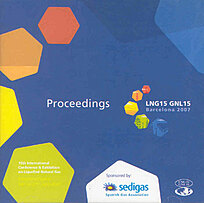
La prochaine génération de grands méthaniers de GNL pour les environnements difficiles.
The next generation of large LNG carriers for long distance and harsh environments.
Auteurs : NOBLE P. G.
Résumé
Growth in the production and ocean trade of LNG has averaged about 6.5% a year over time but has accelerated to about 9% in recent years. Driven by this commercial imperative, technology is being developed to allow new classes of LNG ships to be designed and built. These designs are pushing technological constraints and fuelling innovation. The largest commercial impact on design is the jump in size from conventional LNG carriers of around 145,000 m3 to large LNG carriers up to 265,000 m3 capacity. The larger, size of these next generation carriers is causing the industry to research and develop many design optimizations including, the effects on membrane tank sloshing loads, larger block coefficients, and alternative tank technologies and propulsion options. The paper also looks at even large LNG carriers and discusses the economies of scale of very large ships while at the same time recognizing the challenges of interfacing such large vessels on either end of the supply chain. Further thoughts are given on the use of large LNG carriers in high latitudes trades such as from Canadian Arctic Islands or from Russian Arctic.
Détails
- Titre original : The next generation of large LNG carriers for long distance and harsh environments.
- Identifiant de la fiche : 2008-1135
- Langues : Anglais
- Source : LNG 15. Proceedings of the 15th International Conference and Exhibition of Liquefied Natural Gas.
- Date d'édition : 24/04/2007
Liens
Voir d'autres communications du même compte rendu (43)
Voir le compte rendu de la conférence
Indexation
-
Thèmes :
GNL et GPL;
Applications des gaz liquéfiés - Mots-clés : Méthanier; Transport maritime; Conception; Marché; GNL
-
Advanced LNG carrier with energy saving propuls...
- Auteurs : OHIRA H., SUETAKE Y., OKA M.
- Date : 21/03/2004
- Langues : Anglais
- Source : LNG 14. Proceedings of the 14th international conference and exhibition of liquefied natural gas [CD-ROM].
Voir la fiche
-
THERMODYNAMIC BEHAVIOUR OF LNG DURING MARINE TR...
- Auteurs : TANIGUCHI M., YONEYAMA T.
- Date : 17/10/1989
- Langues : Anglais
Voir la fiche
-
A NEW GENERATION OF LNG CARRIERS BASED ON A PRO...
- Auteurs : JEAN P., BOURGEOIS M.
- Date : 1984
- Langues : Anglais
Voir la fiche
-
Comparative efficiency of natural gas sea trans...
- Auteurs : ODISHARIYA G., IZOTOV N.
- Date : 24/04/2007
- Langues : Anglais
- Source : LNG 15. Proceedings of the 15th International Conference and Exhibition of Liquefied Natural Gas.
Voir la fiche
-
A NEW GENERATION OF SPHERICAL TANK LNG CARRIERS.
- Auteurs : ITOYAMA N.
- Date : 17/10/1989
- Langues : Anglais
Voir la fiche
